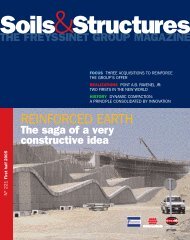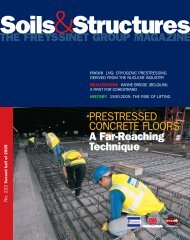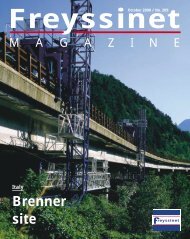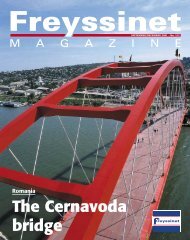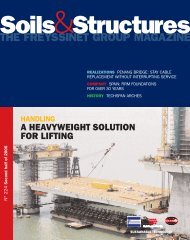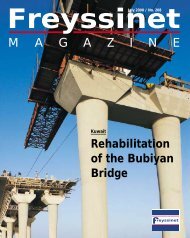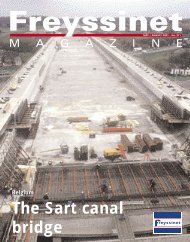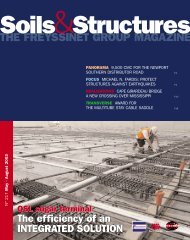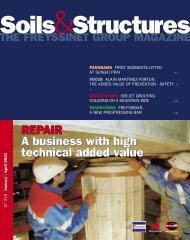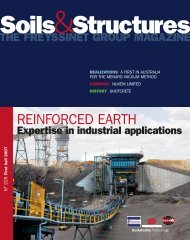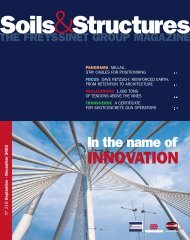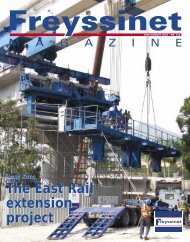STAY CABLE : The System in Top Form N°220 - Freyssinet
STAY CABLE : The System in Top Form N°220 - Freyssinet
STAY CABLE : The System in Top Form N°220 - Freyssinet
You also want an ePaper? Increase the reach of your titles
YUMPU automatically turns print PDFs into web optimized ePapers that Google loves.
F O C U S<br />
JULIO MARTINEZ CALZÓN-MIGUEL GOMEZ NAVARRO<br />
<strong>The</strong> Versatility<br />
of Stay Cables<br />
Julio Mart<strong>in</strong>ez Calzón and Miguel Gomez<br />
Navarro are both eng<strong>in</strong>eers <strong>in</strong> the Spanish<br />
Eng<strong>in</strong>eer<strong>in</strong>g Consultancy Company MC2 and<br />
participated <strong>in</strong> the design of the Valladolid<br />
Science Museum footbridge*. <strong>The</strong>y look back<br />
upon the genesis of this ground-break<strong>in</strong>g<br />
structure, and sketch their vision for the future<br />
of stay cables.<br />
Soils & Structures. -<br />
You helped design the<br />
Valladolid Science<br />
Museum footbridge.<br />
Would you classify it as<br />
a cable-stayed structure<br />
It’s a unique structure<br />
that’s difficult to<br />
categorize. It would<br />
be better described as a<br />
footbridge that is<br />
prestressed with external<br />
cables and equipped<br />
with a cable-stayed<br />
component. An estimate<br />
of the proportions<br />
would be 80%<br />
prestress<strong>in</strong>g and 20%<br />
stay cables. To better<br />
understand this fusion<br />
between external<br />
prestress<strong>in</strong>g and stay<br />
cables, let’s take a look<br />
back at the orig<strong>in</strong>al<br />
project which was<br />
conceived by the<br />
architect José Rafael<br />
Moneo <strong>in</strong> collaboration<br />
with Enrique de Teresa,<br />
the Science Museum<br />
architect. This was<br />
orig<strong>in</strong>ally based on the<br />
form of a fish basket,<br />
and to make this idea<br />
more concrete, we<br />
proposed us<strong>in</strong>g cables<br />
that would add to<br />
the total aesthetics of<br />
the footbridge while<br />
also stabiliz<strong>in</strong>g the<br />
pedestrian area. This<br />
produced the desired<br />
feel<strong>in</strong>g of “spaciousness”.<br />
In short, the structure<br />
evolved through<br />
modification of the<br />
position<strong>in</strong>g of upper,<br />
lower and lateral cables<br />
to yield the desired<br />
effect. In addition, the<br />
Julio Mart<strong>in</strong>ez Calzón.<br />
cross elements, the<br />
functional part of the<br />
footbridge, were given a<br />
hexagonal shape.<br />
Aga<strong>in</strong>, this re<strong>in</strong>forced<br />
the feel<strong>in</strong>g of novelty<br />
and movement procured<br />
while cross<strong>in</strong>g the<br />
structure. For the<br />
stabiliz<strong>in</strong>g cross cables,<br />
we contemplated us<strong>in</strong>g<br />
one s<strong>in</strong>gle cable<br />
anchored to the lower<br />
part and wrapped<br />
around each r<strong>in</strong>g or<br />
polygon of the<br />
footbridge. However,<br />
direction change<br />
problems f<strong>in</strong>ally forced<br />
us to use double cables.<br />
Freyss<strong>in</strong>et performed<br />
all the tests to validate<br />
this design with the<br />
Cohestrand. In summary,<br />
the structure could be<br />
def<strong>in</strong>ed as the dialogue<br />
or correlation between<br />
a very f<strong>in</strong>e metal wire<br />
mesh and a woven net<br />
composed of only<br />
vertical and horizontal<br />
cables.<br />
Does this bold design<br />
make way for a new<br />
conception of cabled<br />
structures<br />
We showed a lot of<br />
creativity <strong>in</strong> the design<br />
of this structure, but<br />
didn’t forge a model<br />
or type of design based<br />
on new cable<br />
comb<strong>in</strong>ations. We do<br />
believe, however, that<br />
cables can create a<br />
powerful aesthetic effect<br />
when they form a group.<br />
Isolated cables should<br />
be reserved for light,<br />
spacious structures<br />
such as build<strong>in</strong>g roofs,<br />
for example. Conversely,<br />
on a bridge, a group is<br />
crucial to the aesthetic<br />
outcome. Whether<br />
they are used for bridges<br />
or for build<strong>in</strong>g roofs,<br />
stay cables and their<br />
architectural<br />
arrangement are a<br />
whim, a fashion<br />
statement. <strong>The</strong>ir future<br />
could be limited.<br />
Dur<strong>in</strong>g the 19th century,<br />
western societies were<br />
likewise <strong>in</strong>fatuated with<br />
arch bridges, which<br />
later almost disappeared,<br />
replaced by l<strong>in</strong>tels,<br />
only to resurface<br />
recently, like a fad.<br />
So, cable-stayed bridges<br />
are a fad<br />
Not exactly.<br />
Clearly, the technique<br />
has been overexploited<br />
without justification<br />
<strong>in</strong> many locations, such<br />
as developed countries<br />
<strong>in</strong> response to client<br />
demand based on<br />
the desire for fashion<br />
or prestige.<br />
Our society has gone<br />
through three phases<br />
of stay cable structure<br />
development.<br />
Dur<strong>in</strong>g the first phase,



